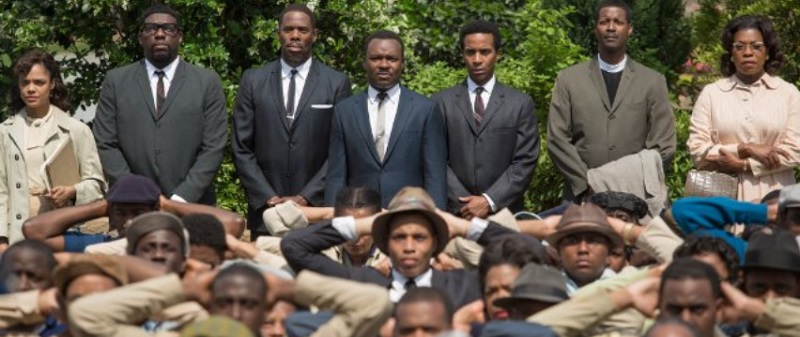Top 10 U.S. Releases of 2014

Click here for some context on this list, or here for its companion list.
Stay tuned for #1-#7! In the meantime...
 8. The Missing Picture Especially compared to the two films further down this list, Rithy Panh's The Missing Picture inspired no controversy at all—except, perhaps, on the question of when exactly it opened. A tiny commercial bow was planned late last year for LA, though evidence suggests no ticket-buyer saw it until last March. Such are the vortices of minutiae into which a Top 10 list gets pulled, when the point is to showcase artistry as keen, inventive, and affecting as Panh's, narrating his country's and his family's experience of the Khmer Rouge takeover of Cambodia in the 1970s. Forsaking a talking-head approach to history, Panh assembles an eclectic archive of stock footage, movie clips, superimpositions, and abstract sound elements that testify to the unstable, prismatic qualities of public and personal history, even as his soft-spoken account of genocide and systemic oppression evokes the stubborn, harrowing factuality of the past. Famously anchoring the film's mix of styles and source materials are Panh's handmade dioramas of Cambodians usurped, imprisoned, indentured, and buried. Watching the film again for the first time since TIFF 2013, I realize how many times I've misremembered these wood-carved villagers as clay sculptures: they're as poignantly expressive as stop-motion figures, as palpably stamped with their creator's doting attention, to such an extent I conflated the two. Whittling and painting them by the dozens—suggesting a mass-production of bodies, but evading tyrannical-conformist connotations by subtly humanizing each doll—Panh tells a gruesome history in terms that he and his audience can bear. Still, The Missing Picture remains, of course, a deeply sobering experience. You could see it as a document of traumatic repetition: not just of immersion in an intolerable history but of daily, painstaking labor that simultaneously puts the past to sleep and wakes it back up. The viewer gets enfolded in a similar ambivalence: you'd love for the man and the country to be able to forget, but you also recognize the necessity of never forgetting how a nation of people were stripped of every individual possession but their spoons; how 250 grams of rice somehow fed 25 people per day; how a nine-year-old boy reported his starving mother for stealing a mango in a field; how the regime's oddly poetic prohibition on poetry ("the spade is your only pen, the rice field your only paper!") unwittingly inspires painful, poetic reflection among those few who survive. Through the titular, oft-repeated conceit of the "missing picture," Panh asserts that despite his film's expressive diversity, notwithstanding every photo and figurine and audio collage, this period in Cambodia's past is defined by what nobody can show. The kernel of history remains out of reach and surpasseth understanding. The Missing Picture may in that sense be a film structured around an omission, but look how beautifully and bravely it struggles to fill that gap.
8. The Missing Picture Especially compared to the two films further down this list, Rithy Panh's The Missing Picture inspired no controversy at all—except, perhaps, on the question of when exactly it opened. A tiny commercial bow was planned late last year for LA, though evidence suggests no ticket-buyer saw it until last March. Such are the vortices of minutiae into which a Top 10 list gets pulled, when the point is to showcase artistry as keen, inventive, and affecting as Panh's, narrating his country's and his family's experience of the Khmer Rouge takeover of Cambodia in the 1970s. Forsaking a talking-head approach to history, Panh assembles an eclectic archive of stock footage, movie clips, superimpositions, and abstract sound elements that testify to the unstable, prismatic qualities of public and personal history, even as his soft-spoken account of genocide and systemic oppression evokes the stubborn, harrowing factuality of the past. Famously anchoring the film's mix of styles and source materials are Panh's handmade dioramas of Cambodians usurped, imprisoned, indentured, and buried. Watching the film again for the first time since TIFF 2013, I realize how many times I've misremembered these wood-carved villagers as clay sculptures: they're as poignantly expressive as stop-motion figures, as palpably stamped with their creator's doting attention, to such an extent I conflated the two. Whittling and painting them by the dozens—suggesting a mass-production of bodies, but evading tyrannical-conformist connotations by subtly humanizing each doll—Panh tells a gruesome history in terms that he and his audience can bear. Still, The Missing Picture remains, of course, a deeply sobering experience. You could see it as a document of traumatic repetition: not just of immersion in an intolerable history but of daily, painstaking labor that simultaneously puts the past to sleep and wakes it back up. The viewer gets enfolded in a similar ambivalence: you'd love for the man and the country to be able to forget, but you also recognize the necessity of never forgetting how a nation of people were stripped of every individual possession but their spoons; how 250 grams of rice somehow fed 25 people per day; how a nine-year-old boy reported his starving mother for stealing a mango in a field; how the regime's oddly poetic prohibition on poetry ("the spade is your only pen, the rice field your only paper!") unwittingly inspires painful, poetic reflection among those few who survive. Through the titular, oft-repeated conceit of the "missing picture," Panh asserts that despite his film's expressive diversity, notwithstanding every photo and figurine and audio collage, this period in Cambodia's past is defined by what nobody can show. The kernel of history remains out of reach and surpasseth understanding. The Missing Picture may in that sense be a film structured around an omission, but look how beautifully and bravely it struggles to fill that gap. 9. American Sniper You know what Clint Eastwood's movie about the "most lethal sniper in American history" lacks even one of? A single scene where Chris Kyle embraces that tag. Every time someone tries to print the legend to his face, he opts for non sequiturs, quick subject-changes, or J.M.W. Turner-esque grunts. Clearly, the film has roundly reimagined Kyle from his real-life namesake, who seemed only too proud to trumpet and
embellish that mythological reputation, for reasons that invite a separate inquiry. Just as clearly, the film's Chris Kyle—an utterly coherent characterization of its own, more challenging to hawks or doves than the real Kyle was—is caught within a vertiginous experience that his own legend does nothing to ease or elucidate. Nationalistic, mission-oriented, smart, dim, haunted, gruff, focused, arrogant, repeatedly humbled, empowered and chilled by a red-meat upbringing, prone to racist word and deed, prone to selfless thought and act, capable of moral reflection but seemingly uneasy with it, capable of giving and receiving and reneging on love, Chris emits a plethora of contradictory attitudes and positions. Sniper never reduces these, even as its hurtling momentum, its inductive approach to character, and the exigencies of battle preclude it from flaunting its own complexity or apologizing for its compromises. "It's a hell of a thing, killin' a man," William Munny apostrophized in Eastwood's grim and heavily lacquered Unforgiven, an accomplished film that foregrounded its own rhetoric; it anticipated and even wooed an audience of artistically inclined revisionists, assuring us that it grasped its moral paradox, that it felt the clamp of guilt. American Sniper, faster, brighter, bloodier, and lodged inside contemporary quagmires,
radiates a similar but less articulated moral despair. Its agonies are expressed everywhere from the arrogant, overwhelming roars of American warcraft to the utterly un-rousing score to the sickening, raspberry blasts of blood that accompany every kill. It neither characterizes a single Iraqi in depth nor presses very far into most of its American characters nor shows almost any Iraqi (with one Guignol, discordant exception) doing anything I wouldn't imagine an American doing in the reverse position... if we can even imagine ourselves in the reversed position. Sniper's reception suggests that many pro- and anti-war audiences and critics expect films on this subject to come right out and flatter them in undiluted terms. This film doesn't do that. Exceptionally well-made, well-shot, well-mixed, and with a tension in the cutting that few Eastwood movies and few modern war films have achieved, American Sniper is as cinematically deft as it is culturally divisive. Op/eds and awards pundits keep trying to spin it as the anti-Selma. I look at the pair of them, one an exhortation for justice and the other a hydrochloric assault on ethical conviction—one a study of a group challenging The System, the other a study of a man who, for better and worse, subsumed himself to a system—and I think these two Best Picture nominees are the two bravest, and the two most worth saving. In serious terms, with both feet planted in the real world, they showcase complex men and communities that too few movies ask us to consider, much less to assess in such rounded, inspiring, but discomfiting ways. Which, speaking of...
9. American Sniper You know what Clint Eastwood's movie about the "most lethal sniper in American history" lacks even one of? A single scene where Chris Kyle embraces that tag. Every time someone tries to print the legend to his face, he opts for non sequiturs, quick subject-changes, or J.M.W. Turner-esque grunts. Clearly, the film has roundly reimagined Kyle from his real-life namesake, who seemed only too proud to trumpet and
embellish that mythological reputation, for reasons that invite a separate inquiry. Just as clearly, the film's Chris Kyle—an utterly coherent characterization of its own, more challenging to hawks or doves than the real Kyle was—is caught within a vertiginous experience that his own legend does nothing to ease or elucidate. Nationalistic, mission-oriented, smart, dim, haunted, gruff, focused, arrogant, repeatedly humbled, empowered and chilled by a red-meat upbringing, prone to racist word and deed, prone to selfless thought and act, capable of moral reflection but seemingly uneasy with it, capable of giving and receiving and reneging on love, Chris emits a plethora of contradictory attitudes and positions. Sniper never reduces these, even as its hurtling momentum, its inductive approach to character, and the exigencies of battle preclude it from flaunting its own complexity or apologizing for its compromises. "It's a hell of a thing, killin' a man," William Munny apostrophized in Eastwood's grim and heavily lacquered Unforgiven, an accomplished film that foregrounded its own rhetoric; it anticipated and even wooed an audience of artistically inclined revisionists, assuring us that it grasped its moral paradox, that it felt the clamp of guilt. American Sniper, faster, brighter, bloodier, and lodged inside contemporary quagmires,
radiates a similar but less articulated moral despair. Its agonies are expressed everywhere from the arrogant, overwhelming roars of American warcraft to the utterly un-rousing score to the sickening, raspberry blasts of blood that accompany every kill. It neither characterizes a single Iraqi in depth nor presses very far into most of its American characters nor shows almost any Iraqi (with one Guignol, discordant exception) doing anything I wouldn't imagine an American doing in the reverse position... if we can even imagine ourselves in the reversed position. Sniper's reception suggests that many pro- and anti-war audiences and critics expect films on this subject to come right out and flatter them in undiluted terms. This film doesn't do that. Exceptionally well-made, well-shot, well-mixed, and with a tension in the cutting that few Eastwood movies and few modern war films have achieved, American Sniper is as cinematically deft as it is culturally divisive. Op/eds and awards pundits keep trying to spin it as the anti-Selma. I look at the pair of them, one an exhortation for justice and the other a hydrochloric assault on ethical conviction—one a study of a group challenging The System, the other a study of a man who, for better and worse, subsumed himself to a system—and I think these two Best Picture nominees are the two bravest, and the two most worth saving. In serious terms, with both feet planted in the real world, they showcase complex men and communities that too few movies ask us to consider, much less to assess in such rounded, inspiring, but discomfiting ways. Which, speaking of... 10. Selma A great tweeter called @DanBlackroyd came up with these apt words, angry but beautiful and totally on-point, following that notoriously low tally of Oscar nods: "Selma will be written about for years to come. Its legacy is intact. The Academy needed Selma way more than the other way around. Trust." He's so right. But if you wanted to parse the thought differently, part of why the Academy needs this movie, and why this movie merits more awards, is that it's the rare film that unabashedly needs us—that
reaches for us and involves us. It's not the kind of historical drama
that unfolds behind plate glass. Beyond its epic yet intimate staging
of events in the mid 1960s (superlative), beyond its close but woeful
presaging of events in the mid 2010s (urgent and humbling), observe the
consummate engineering of the film. Its broadest arc moves from an
opening, monolithic close-up on one man to a closing, diamantine montage
of thousands. It pivots on sequences like the second attempted march
toward Montgomery, which King unexpectedly halts. Minutes go by before
the film spells out his thought process, enlisting us in the meantime to
do the necessary work, to practice thinking like an activist, to deduce why this counter-intuitive move could possibly make sense in the
moment... which does not, by the way, mean forbidding us or the other characters from questioning King's wisdom. Selma inspires us to feel and to cogitate, and to act in our communities. To act as communities! The film percolates
with expansive ideas and also with subtle filigrees of framing,
figuration, and form. Not just in content but in its texture and its
frequently self-effacing technique, Selma honors the candid but
deceptively complicated man at its center, and it honors even more that
ethos of coalition, resilience, and solidarity for which both Kings and
Lewis and Abernathy and Nash and Rustin Cooper and Boynton and Young and
Williams and their many colleagues all stood (and sometimes knelt, and
occasionally fell). Selma sparks our memories, solicits our
horror, and mobilizes our sense of what's right—not for each of us individually, but for all of us together.
10. Selma A great tweeter called @DanBlackroyd came up with these apt words, angry but beautiful and totally on-point, following that notoriously low tally of Oscar nods: "Selma will be written about for years to come. Its legacy is intact. The Academy needed Selma way more than the other way around. Trust." He's so right. But if you wanted to parse the thought differently, part of why the Academy needs this movie, and why this movie merits more awards, is that it's the rare film that unabashedly needs us—that
reaches for us and involves us. It's not the kind of historical drama
that unfolds behind plate glass. Beyond its epic yet intimate staging
of events in the mid 1960s (superlative), beyond its close but woeful
presaging of events in the mid 2010s (urgent and humbling), observe the
consummate engineering of the film. Its broadest arc moves from an
opening, monolithic close-up on one man to a closing, diamantine montage
of thousands. It pivots on sequences like the second attempted march
toward Montgomery, which King unexpectedly halts. Minutes go by before
the film spells out his thought process, enlisting us in the meantime to
do the necessary work, to practice thinking like an activist, to deduce why this counter-intuitive move could possibly make sense in the
moment... which does not, by the way, mean forbidding us or the other characters from questioning King's wisdom. Selma inspires us to feel and to cogitate, and to act in our communities. To act as communities! The film percolates
with expansive ideas and also with subtle filigrees of framing,
figuration, and form. Not just in content but in its texture and its
frequently self-effacing technique, Selma honors the candid but
deceptively complicated man at its center, and it honors even more that
ethos of coalition, resilience, and solidarity for which both Kings and
Lewis and Abernathy and Nash and Rustin Cooper and Boynton and Young and
Williams and their many colleagues all stood (and sometimes knelt, and
occasionally fell). Selma sparks our memories, solicits our
horror, and mobilizes our sense of what's right—not for each of us individually, but for all of us together.Labels: American Sniper, Ava DuVernay, Black Cinema, Clint Eastwood, Documentary, International, Political Cinema, Selma, U.S. Releases, War Films
 Nick's Flick Picks: The Blog
Nick's Flick Picks: The Blog




















